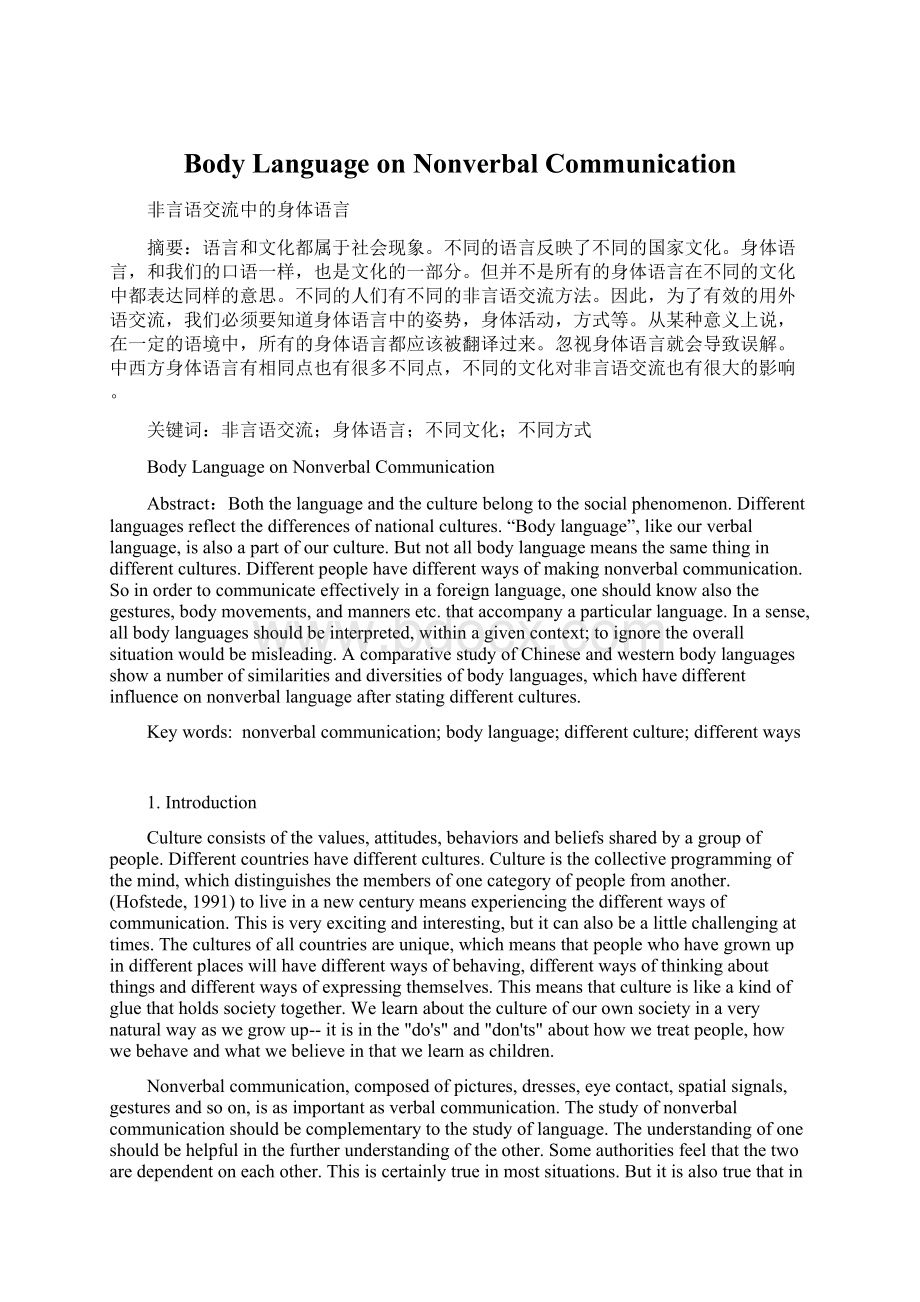 Body Language on Nonverbal CommunicationWord文档下载推荐.docx
Body Language on Nonverbal CommunicationWord文档下载推荐.docx
- 文档编号:20476547
- 上传时间:2023-01-23
- 格式:DOCX
- 页数:9
- 大小:25.22KB
Body Language on Nonverbal CommunicationWord文档下载推荐.docx
《Body Language on Nonverbal CommunicationWord文档下载推荐.docx》由会员分享,可在线阅读,更多相关《Body Language on Nonverbal CommunicationWord文档下载推荐.docx(9页珍藏版)》请在冰豆网上搜索。

因此,为了有效的用外语交流,我们必须要知道身体语言中的姿势,身体活动,方式等。
从某种意义上说,在一定的语境中,所有的身体语言都应该被翻译过来。
忽视身体语言就会导致误解。
中西方身体语言有相同点也有很多不同点,不同的文化对非言语交流也有很大的影响。
关键词:
非言语交流;
身体语言;
不同文化;
不同方式
Body
Language
on
Nonverbal
Communication
Abstract:
Boththelanguageandtheculturebelongtothesocialphenomenon.Differentlanguagesreflectthedifferencesofnationalcultures.“Bodylanguage”,likeourverballanguage,isalsoapartofourculture.Butnotallbodylanguagemeansthesamethingindifferentcultures.Differentpeoplehavedifferentwaysofmakingnonverbalcommunication.Soinordertocommunicateeffectivelyinaforeignlanguage,oneshouldknowalsothegestures,bodymovements,andmannersetc.thataccompanyaparticularlanguage.Inasense,allbodylanguagesshouldbeinterpreted,withinagivencontext;
toignoretheoverallsituationwouldbemisleading.AcomparativestudyofChineseandwesternbodylanguagesshowanumberofsimilaritiesanddiversitiesofbodylanguages,which
havedifferentinfluenceonnonverballanguageafterstatingdifferentcultures.
Keywords:
nonverbalcommunication;
bodylanguage;
differentculture;
differentways
1.Introduction
Cultureconsistsofthevalues,attitudes,behaviorsandbeliefssharedbyagroupofpeople.Differentcountrieshavedifferentcultures.Cultureisthecollectiveprogrammingofthemind,whichdistinguishesthemembersofonecategoryofpeoplefromanother.(Hofstede,1991)toliveinanewcenturymeansexperiencingthedifferentwaysofcommunication.Thisisveryexcitingandinteresting,butitcanalsobealittlechallengingattimes.Theculturesofallcountriesareunique,whichmeansthatpeoplewhohavegrownupindifferentplaceswillhavedifferentwaysofbehaving,differentwaysofthinkingaboutthingsanddifferentwaysofexpressingthemselves.Thismeansthatcultureislikeakindofgluethatholdssocietytogether.Welearnaboutthecultureofourownsocietyinaverynaturalwayaswegrowup--itisinthe"
do'
s"
and"
don'
ts"
abouthowwetreatpeople,howwebehaveandwhatwebelieveinthatwelearnaschildren.
Nonverbalcommunication,composedofpictures,dresses,eyecontact,spatialsignals,gesturesandsoon,isasimportantasverbalcommunication.Thestudyofnonverbalcommunicationshouldbecomplementarytothestudyoflanguage.Theunderstandingofoneshouldbehelpfulinthefurtherunderstandingoftheother.Someauthoritiesfeelthatthetwoaredependentoneachother.Thisiscertainlytrueinmostsituations.Butitisalsotruethatinsomecertainsituationbodyactioncontradictswhatisbeingsaid,justasthespokenwordsmaymeansomethingquitedifferentfromwhatnonverbalcommunicationcommunicates.Whenthisoccurs,onemusttrytogetfurtherinformation,orguessthemeaningfromthecontextofthesituation.Inacase,allnonverbalcommunicationshouldbeinterpretedwithinacertaingivencontext;
toignoretheoverallsituationcouldbemisleading.Therefore,inthispaper,weattempttodiscusstheinterculturaldifferencesinbodylanguage,especiallythoseingesture,posture,eyelanguage,touchanddistance.
2.TheNecessityandImportanceofLearningBodyLanguageonNonverbalCommunication
Althoughwemaynotrealizeit,whenweconversewithotherswecommunicatebymuchmorethanwords.Byourexpressions,gesturesandotherbodymovementswesendmessagestothosearoundus;
asmileandanoutstretchedhandshowwelcome.Aformisasignofpleasure.Noddingone’sheadmeansagreement—“Yes”.Wavinganoutstretchedhandwithopenpalmisthegesturefor“goodbye”.Leaningbackinone’sseatandyawningatatalkorlectureshowslackofinterest,boredom.Thesegestureshavecometobeacceptedingeneralashavingthemeaningsmentioned,atleasttoChineseandAmericans.Therearepartsofthewayinwhichwecommunicate.This“bodylanguage”,likeourverballanguage,isalsoapartofourculture.Butnotallbodylanguagemeansthesamethingindifferentcultures.Differentpeoplehavedifferentwaysofmakingnonverbalcommunication.Soinordertocommunicateeffectivelyinaforeignlanguage,oneshouldknowalsothegestures,bodymovements,mannerismsetc.thataccompanyaparticularlanguage.
Bodylanguageisanimportantwaythroughwhichpeoplecommunicatewitheachother.Sometimebodylanguageprevailsoverwords.Itreferstothepatternsoffacialexpressionsandgesturesthatpeopleusetoexpresstheirfeelingsincommunication.Thespecialistonbodylanguageresearch—Fen·
Lafle·
Angles,oncesaid:
"
Onceitwaslost,ababycouldn’thavegrownintoanormalperson"
.It’salsotruetothejuveniles.Inschooleducation,bodylanguageplaysapositiveroleincultivatingthestudents’characters.
3.TheConcreteTypesandApplicationoftheBodyLanguage
3.1
Typesofbodylanguage
3.1.1
Distancebetweenpeopleconversing
Distancebetweenthetwoisthekeyfactor.Differentpeoplehavedifferentideasabouttheproperdistancebetweenpeopleconversing.WehavefoundthattheimportantthingtokeepinmindisthatmostEnglish-speakingpeopledonotlikepeopletobetooclose.Beingtoofarapart,ofcourse,maybeawkward,butbeingtooclosemakespeopleuncomfortable,unlessthereisareason,suchasshowingaffectionorencouragingintimacy.Butthatisanothermatter.InsomeAsiancountries,itisquitecommontoseepeopleshovingandcrowdingonbusesandinmostpublicplaces,whichmightstartletheEnglish-speakingpeoplegreatly.Therefore,thelackofknowledgeofculturaldifferencesmayleadtoconsiderablemisunderstanding.
3.1.2
InEnglish-speakingcountries,physicalcontactinconversationisgenerallyavoidedamongordinaryfriendsoracquaintances.
Theappropriatenessofphysicalcontactvarieswithdifferentcultures.InEnglish–speakingcountries,physicalcontactisgenerallyavoidedinconversationamongordinaryfriendsoracquaintances.Merelytouchingsomeonemaycauseanunpleasantreaction.Ifonetouchesanotherpersonaccidentally,he/sheusuallyuttersanapologysuchas“Sorry’’,“Oh”,“I’msorry”,“Excuseme”,etc.
In
China,acommoncomplaintofwesternmothersisthatChineseoftenfondletheirbabiesandverysmallchildren.Suchbehavior—whethertouching,patting,huggingorkissing—canbequiteembarrassingandawkwardforthemothers.Theyknowthatnoharmismeant,andthatsuchgesturesaremerelysignsoffriendlinessoraffection,thereforetheycannotopenlyshowtheirdispleasure.Ontheotherhand,suchactionsintheirownculturewouldbeconsideredrude,intrusiveandoffensive,andcouldarouseastrongdislikeandevenrepugnance.Sothemothers
oftenstandbyandwatchinawkwardsilence,withmixedemotions,evenwhenthefondlingis
required
byChinesefriendsoracquaintances.
ThematterofphysicalcontactbetweenmembersofthesamesexinEnglish-speakingcountriesisadelicateone.Oncepastchildhood,theholdingofhands,orwalkingwithanarmaroundanother’sshoulderisnotconsideredproper.Theimplicationishomosexuality,andhomosexualitygenerallyarousesstrongsocialdisapprovalinthesecountries.
3.1.3
Eyecontact
Eyecontactisanimportantaspectofbodylanguage.Onecoulddrawupquitealistof“rules”abouteyecontact:
tolookornottolook;
whentolookandhowlongtolook;
whoandwhomnottolookat.
Inconversationswithpeoplewhoknoweachother,however,Americancustomdemandsthatthereshouldbeeyecontact.Thisappliestoboththespeakerandthelistener.Foreitheronenottolookattheotherpersoncouldimplyanumberofthings,amongwhicharefear,contempt,uneasiness,guilt,indifference…eveninpublicspeakingthereshouldbeplentyofeyecontact.Foraspeakerto“bury
hisnoseinhismanuscript”,toreadaspeechinsteadoflookingatandtalkingtohiddenaudience,assomeChinesespeakersareinthehabitofdoing,wouldberegardedasinconsiderateanddisrespectful.
Inconversations,apersonshowsthatheislisteningbylookingattheotherperson’seyesorface.Iftheotherpersonisspeakingatsomelength,thelistenerwilloccasionallymakesoundslike“Hmm”,“Ummm”,ornodhisheadtoindicatehisattention.Ifheagreeswiththespeaker,hemaynodorsmile.Ifhedisagreesorhassomereservations,hemayslanthisheadtooneside,raiseaneyebrow,andhaveaquizzicallook.
Theeyescommunicatemorethananyotherpartofthehumananatomy.Staringorgazingatotherscancreatepressureortensionintheroom.Gangshavefoughtoverthewaysomeonelookedatthem.Shiftyeyes,toomuchblinkingcansuggestdeception.Peoplewitheyemovementsthatarerelaxedandcomfortable,yetattentivetothepersontheyareconversingwithareseenasmoresincereandhonest.
“Thelanguageoftheeyes”—oneofthemostcommonandancientwaysofexchangingfeelingsbetweenboysandgirls,menandwomen—isespeciallyelaborateinthe
UnitedStates.Muchstudyhasbeenmadeofthis:
howpeopleoftheoppositesexshowinterestorindifference,encouragementordiscouragement,approvalordisapproval,affectionoraversion.However,therearemanydifferencesevenwithinthe
UnitedStates.
Menusetheireyesindifferentwayswomendo;
therearedifferencesofage,classorsocialstatusandgeographicalregion;
therearedifferencesofethnicbackground.
ThestoryistoldofateenagePuertoRicangirlina
NewYork
highschoolwhowastakenwithanumberofothergirlstotheprincipalforsuspectedsmoking.Althoughtherewasnoproofofanywrongdoingandalthoughshehadagoodrecord,theprincipaldecidedshewasguiltyandsuspendedher.“Therewassomethingsl
- 配套讲稿:
如PPT文件的首页显示word图标,表示该PPT已包含配套word讲稿。双击word图标可打开word文档。
- 特殊限制:
部分文档作品中含有的国旗、国徽等图片,仅作为作品整体效果示例展示,禁止商用。设计者仅对作品中独创性部分享有著作权。
- 关 键 词:
- Body Language on Nonverbal Communication
 冰豆网所有资源均是用户自行上传分享,仅供网友学习交流,未经上传用户书面授权,请勿作他用。
冰豆网所有资源均是用户自行上传分享,仅供网友学习交流,未经上传用户书面授权,请勿作他用。
链接地址:https://www.bdocx.com/doc/20476547.html


 铝散热器项目年度预算报告.docx
铝散热器项目年度预算报告.docx
 雌孕激素制剂在妇科疾病中的应用.ppt
雌孕激素制剂在妇科疾病中的应用.ppt
